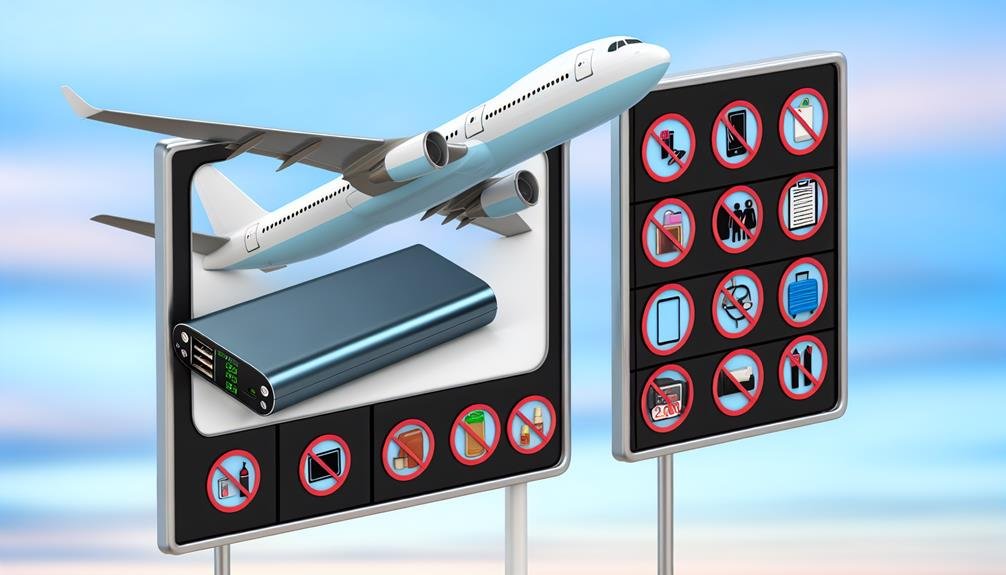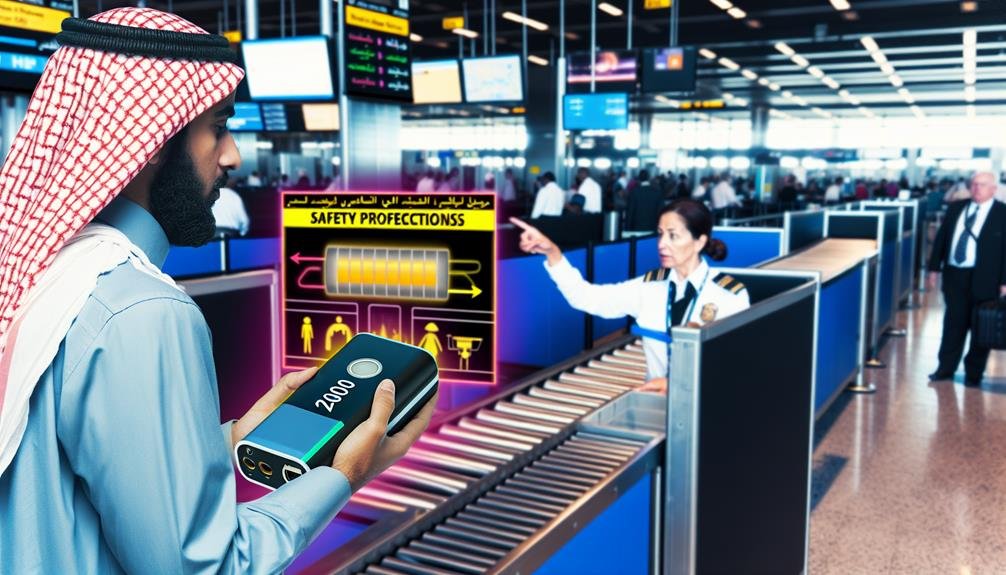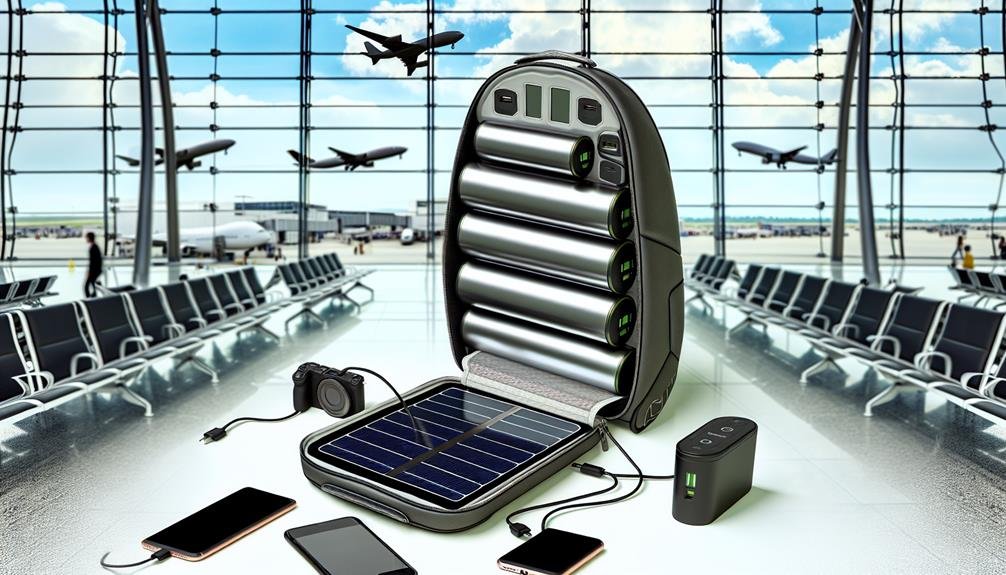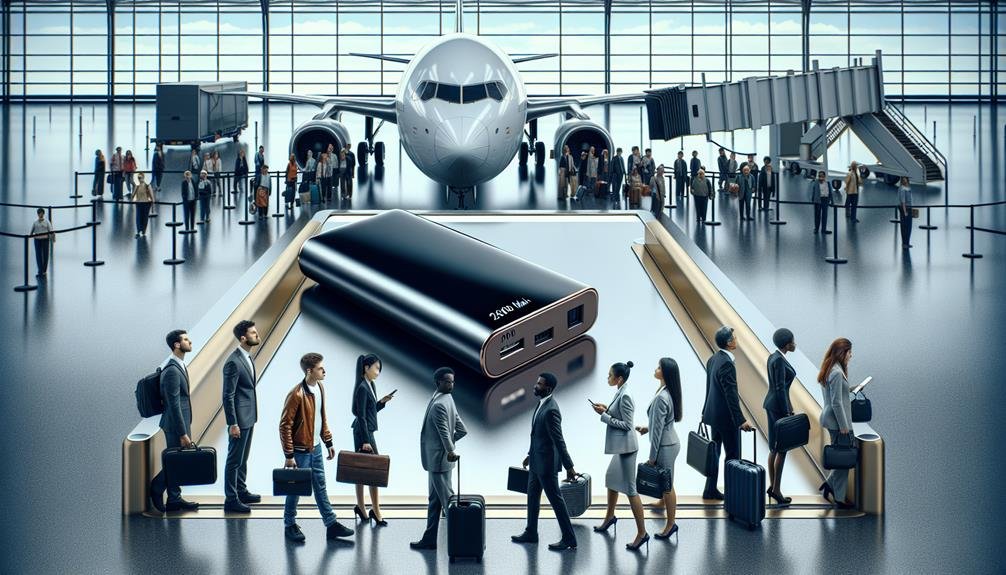Yes, you can bring a 20000 mAh power bank on a flight. Most airlines allow power banks up to 27000 mAh (100 watt-hours) in carry-on luggage. Make certain the power bank is in your carry-on, not checked baggage, to comply with airline regulations. It's wise to check the specific guidelines of your airline and verify the power bank is in good condition and properly stored in a protective case. This will help avoid any safety issues or confiscation. Checking airline policies and packing tips will further streamline your air travel experience.
Airline Regulations

When carrying a 20000 mAh power bank on a flight, it's important to follow airline regulations to guarantee a smooth travel experience. Airline policies regarding power banks are designed to maintain the safety of all passengers. These rules can vary depending on the airline and the country you're flying to or from, making it essential to be aware of specific guidelines for international travel.
Most airlines allow you to carry power banks with certain mAh limits in your carry-on luggage, but they often prohibit them in checked baggage. Generally, power banks up to 100 watt-hours (Wh) or 27000 mAh are permitted without prior approval. However, exceeding these limits might require special clearance from the airline. Always check the airline's website or contact their customer service for detailed information on their policies.
Ensuring that your power bank complies with these regulations minimizes the risk of confiscation and enhances your overall travel safety. By adhering to airline policies, you can make your travel experience more seamless and reduce the likelihood of encountering issues at security checkpoints. This proactive approach not only safeguards your belongings but also maintains the safety and comfort of everyone on board.
Understanding Mah Limits
To fully adhere to airline regulations, it's essential to comprehend the mAh limits for power banks allowed on flights. Most airlines impose restrictions on the mAh capacity of power banks to guarantee passenger safety. Generally, power banks up to 100Wh (Watt-hours) are permitted, which, when converted, roughly equates to around 27,000 mAh for a standard 3.7V power bank. However, individual airlines might have more stringent rules, so it's important to check with your specific carrier.
Considerations for battery life also come into play. Higher mAh capacity means longer battery life, but it also means complying with regulations becomes more demanding. For power banks exceeding 100Wh but under 160Wh, special airline approval might be required, and typically, no more than two such devices are allowed per passenger. Anything above 160Wh is usually prohibited in both carry-on and checked baggage.
Understanding these restrictions is essential not just for compliance but for ensuring a safe travel environment. Make sure to verify the mAh capacity of your power bank and compare it against the airline's specific limits before you fly. This proactive approach guarantees a smooth and hassle-free journey.
Safety Precautions

How can you guarantee carrying a 20,000 mAh power bank on a flight doesn't compromise safety? First, always verify your power bank adheres to airline travel restrictions regarding battery capacity. Most airlines allow lithium ion batteries up to 100 watt-hours (Wh), roughly equivalent to 27,000 mAh at 3.7 volts. Since a 20,000 mAh power bank usually falls within this limit, you're generally safe, but always confirm with your airline.
Lithium ion batteries need to be in your carry-on luggage, not checked baggage. This is essential because carry-on luggage restrictions are designed to mitigate fire hazards. Lithium ion batteries can overheat, and having them in the cabin allows crew members to address any issues swiftly. To further enhance safety, keep your power bank in its original packaging or a protective case to prevent accidental short circuits.
Additionally, inspect your power bank for any visible damage. Dents, swelling, or leaks can indicate compromised integrity, posing significant risks. If you notice any of these signs, it's better to leave the power bank behind. By following these guidelines, you can verify that your power bank doesn't become a safety concern during your flight.
Packing Tips
Securing your power bank is just the beginning; packing it correctly can make your travel experience smoother and stress-free. Start by including it in your carry-on luggage, as airlines typically don't allow power banks in checked baggage. Use a dedicated pouch for your power bank to prevent it from shifting and potentially getting damaged. This not only safeguards your device but also adheres to safety regulations.
Next, consider packing essentials like a sturdy case for your travel gadgets and tech accessories. This keeps everything organized and easily accessible during security checks. Use cable organizers to prevent tangling, and make sure your power bank and other tech items are easily reachable without having to rummage through your bag.
Organization tips for frequent travelers include creating a designated tech compartment in your carry-on. Place your power bank, chargers, adapters, and other tech accessories in this section for streamlined access. Additionally, label your cables and devices to quickly identify them.
Lastly, always check the airline's guidelines on power banks to avoid any last-minute hassles. Following these packing tips can guarantee your travel gadgets are safe and your journey is hassle-free.
Alternative Solutions

If you're concerned about carrying a 20000 mAh power bank on a flight, consider smaller power bank options that comply with airline regulations. Many aircraft now offer onboard device charging, reducing the need for large external batteries. Alternatively, portable solar chargers can be an eco-friendly and travel-friendly solution.
Smaller Power Bank Options
When traveling by air, opting for smaller power banks under 10,000 mAh can provide a convenient and compliant alternative to larger capacity options. Pocket-sized chargers are ideal for this purpose, as they are lightweight options that fit easily into your carry-on without adding significant bulk or weight. These compact power banks are not only easy to carry but also meet the airline regulations more comfortably, ensuring you won't face any issues during security checks.
Choosing these convenient choices doesn't mean compromising on performance. Modern compact power banks are equipped with advanced technology to deliver efficient charging, often featuring multiple ports and fast-charging capabilities. This makes them an excellent option for keeping your devices powered throughout your journey without the hassle of managing cumbersome equipment.
Additionally, smaller power banks are less likely to cause safety concerns, as their lower capacity reduces the risk of overheating or other potential hazards. By selecting a power bank under 10,000 mAh, you prioritize both convenience and safety, ensuring a smooth travel experience. Remember, when it comes to air travel, smaller and more efficient options can often provide the best balance between compliance and necessity.
Onboard Device Charging
Airlines often provide alternative options for device charging onboard, guaranteeing you can keep your electronics powered without relying solely on personal power banks. These choices consider battery capacity and charging restrictions, providing a safe and dependable way to stay connected during your flight.
- In-seat power outlets: Many modern aircraft feature power outlets at each seat, compatible with various plug types.
- USB ports: Some airlines have integrated USB charging ports into seats, allowing you to charge devices directly via USB cables.
- In-flight entertainment systems: Certain airlines offer integrated charging solutions within their in-flight entertainment systems, available at the touch of a button.
- Power banks offered by airlines: On some flights, airlines may offer their own power banks, ensuring they meet all regulatory requirements for battery capacity and charging restrictions.
Using these onboard charging solutions not only keeps your devices running but also adheres to airline safety protocols. It's essential to check with your airline beforehand to understand the specific charging facilities available on your flight. By utilizing these alternatives, you can avoid the hassle of managing personal power banks and guarantee compliance with all safety regulations.
Portable Solar Chargers
For those seeking eco-friendly and versatile charging options, portable solar chargers offer a reliable alternative to traditional power banks. These devices harness solar panel technology to convert sunlight into electrical energy, making them an excellent choice for travelers who want to reduce their environmental impact. Not only do they provide a sustainable energy source, but they also eliminate the need for outlets, making them ideal for outdoor adventures and emergencies.
When it comes to energy efficiency, modern portable solar chargers have made significant advancements. Many models now feature high-efficiency solar panels that can charge your devices quickly, even in partially cloudy conditions. This means you won't have to worry about running out of power, whether you're on a long flight or in a remote location.
In terms of safety, portable solar chargers are generally very safe to use. They don't carry the same risks as lithium-ion batteries in traditional power banks, such as overheating or leaking. Additionally, their reliance on sustainable energy sources aligns with a growing emphasis on reducing carbon footprints.
Personal Experiences
Many travelers have found that carrying a 20000 mAh power bank on a flight offers peace of mind and convenience, especially on long journeys. It's become a staple in travel essentials for ensuring that your electronic devices remain charged and functional throughout your trip. When selecting power bank options, consider features like multiple USB ports and fast-charging capabilities.
Navigating airport security can be straightforward if you adhere to guidelines for electronic devices. Travelers often share that placing your power bank in your carry-on, not checked luggage, is essential. This practice complies with most airline regulations and guarantees easy access during security checks.
Here are some insights from frequent flyers:
- Peace of Mind: Knowing your devices won't die mid-flight is a significant relief.
- Convenience: No more scrambling for limited charging ports at the airport.
- Compliance: Following airline rules for carrying power banks avoids unnecessary delays.
- Versatility: A high-capacity power bank can charge multiple devices, from phones to tablets.
These personal experiences underscore the significance of choosing the right power bank and understanding airport security protocols. By doing so, you can travel confidently, knowing your electronic devices will stay powered throughout your journey.
Frequently Asked Questions
What Are the Consequences of Carrying an Unapproved Power Bank?
Did you know that 70% of airport incidents involve banned items? Carrying an unapproved power bank poses safety hazards and security risks. You could face legal implications and fines, compromising everyone's safety. Always check airline regulations.
Can Power Banks Be Used During the Flight?
Yes, you can use power banks for in-flight charging, but make sure you follow airline regulations for power bank safety. Always check with your airline's policies to guarantee your device's compliance and prevent any safety issues.
How Do I Check the Capacity of My Power Bank?
To guarantee power bank safety, checking capacity is vital. Look for the mAh rating on the power bank's label or in the user manual. It's typically printed clearly, making it easy to verify before your flight.
Are There Specific Brands of Power Banks Recommended for Air Travel?
For air travel, it's important to choose power banks from the best brands like Anker or RAVPower. Always check airline restrictions, as they often limit battery capacity to guarantee passenger safety.
Do International Flights Have Different Rules for Power Banks?
Yes, international flights can have different power bank regulations. Always check airline policies before traveling to make sure your power bank complies with their safety standards. This helps you avoid confiscation or delays during your journey.



